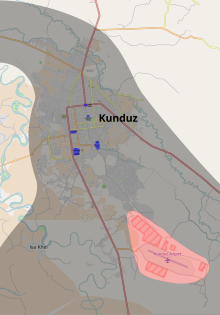Battle of Kunduz
| Battle of Kunduz | |||||||
|---|---|---|---|---|---|---|---|
| Part of the War in Afghanistan (2015–present) | |||||||
 Situation on 27 September, after the Taliban had pushed ANA forces back to the airport.
Controlled by the Afghan National Security Forces
|
|||||||
|
|||||||
| Belligerents | |||||||
|
Supported by: |
|||||||
| Commanders and leaders | |||||||
|
(President of Afghanistan) (Acting Defense Minister) (Chief of the General Staff of the Afghan Armed Forces) |
(Deputy leader) (Disputed)(Shadow governor of Kunduz) |
||||||
| Strength | |||||||
| 5,000–7,000+ | 1,500 (~500 in initial seizure of Kunduz) | ||||||
| Casualties and losses | |||||||
| Undisclosed | 80–200 killed (Afghan government claim; denied by Taliban) | ||||||
|
Killed: 848+ civilians (U.N. report) 100,000 displaced (over entire offensive) |
|||||||
|
|
|||||||
Afghan victory
![]() Islamic Republic of Afghanistan
Islamic Republic of Afghanistan
Supported by:![]() Resolute Support Mission
Resolute Support Mission
![]() Akhtar Mansoor
Akhtar Mansoor
(Supreme Commander)
The Battle of Kunduz took place from April to October 2015 for control of the city of Kunduz, located in northern Afghanistan, with Taliban fighters attempting to displace Afghan security forces. On 28 September 2015, the Taliban forces suddenly overran the city, with government forces retreating outside of the city. The capture marked the first time since 2001 that the Taliban had taken control of a major city in Afghanistan. The Afghan government claimed to have largely recaptured Kunduz by 1 October 2015 in a counterattack, although local sources in the city disputed the claim made by government officials.
...
Wikipedia

